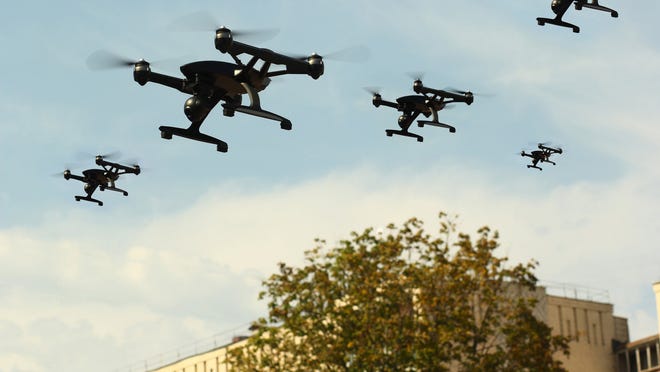[ad_1]

Over a million hobby drones are registered in the U.S. You may never know when you’re being watched. Check out my guide to avoiding drone surveillance. We wrote this after one hovered over my pool while I was swimming.
Ever stay in an Airbnb? Hosts sometimes spy on their guests with hidden cameras. Yes, that happened to me too. Use these tricks to catch them in the act.
Police departments are stepping up their surveillance, adding drones to their tech collection. How closely does your local department monitor you? Here’s a searchable website you can use to see:
Atlas of Surveillance
The Atlas of Surveillance is a searchable database project from the Electronic Frontier Foundation. It shows which surveillance technologies – such as drones, automated license plate readers, and facial recognition – are used by law enforcement agencies across the U.S.
The pilot program began as a collaboration between the Electronic Frontier Foundation and the University of Nevada’s Reno Reynolds School of Journalism in 2019.
The information comes from public records, crowdsourcing, data journalism, news stories, social media posts, press releases, and volunteer assistance. As of November 2022, the Atlas of Surveillance has 10,000 data points, with at least partial data on 5,500 law enforcement agencies in all 50 states, plus most territories and districts.
The Atlas of Surveillance site says its information is only as good as the source and that government agencies can withhold information. Plus, there’s always the chance of misinterpretation.
While it’s impossible to fact-check every data point, each one is reviewed by multiple journalism students and staff. Let’s have a closer look at what it shows.
Have a DJI drone? Beware of this serious security flaw allowing someone to take over and see your location.
Types of surveillance in use around the country
Does a camera on every street corner make you nervous? Do you worry that your face is constantly being scanned against a database of who-knows-who? Some people don’t mind it, and others are really bothered by it.
The Atlas of Surveillance lets you search and view databases containing the following examples of surveillance:
• Automated License Plate Readers: Cameras attached to fixed locations or police cars that track license plates.
• Body-worn Cameras: Video cameras attached to police uniforms.
• Camera Registry: A voluntary registry of security cameras people have installed on their properties. Would you let police access your private security cameras any time they want? Hear my take on this experimental program.
• Cell-site Simulator: Fake cellphone towers used to spy on people’s phones.
• Drones: Aerial vehicles police use to gather footage from above.
• Face Recognition: Software that identifies a person from their face.
• Fusion Center: Intelligence centers that enable information sharing between local, state, tribal, territorial, and federal agencies.
• Gunshot Detection: Acoustic sensors attached to street lights or buildings that passively listen for the sound of gunfire.
• Predictive Policing: Software that suggests neighborhoods or people that need more police attention.
• Real-Time Crime Center: Police analyze surveillance video, intelligence, and other data from these hubs.
• Ring/Neighbors Partnership: Many police departments have partnerships with Ring. Have a Ring camera? Here’s how police can get your footage without permission.
• Video Analytics: Computers automatically analyze video footage and feeds.
Interactive map
The Atlas is a map with over 10,000 data points across the country. Go to atlasofsurveillance.org/atlas to get started.
• Toggle data points on and off from the legend and zoom in and out as needed.
• Click on a data point for more information, such as the technology being employed, which department is using it, a summary of the system, and source links.
See what’s going on in your area
Want to narrow your search? Go to atlasofsurveillance.org/search to access a searchable database. Then:
• Enter a city, county, state, or agency in the U.S. and hit Update Search.
• Click more info on any result to get more information on the technology, the agency using it, the vendor, and more.
• Select or deselect the data you want to see from the list on the left.
Keep your tech-know going
My popular podcast is called “Kim Komando Today.” It’s a solid 30 minutes of tech news, tips, and callers with tech questions like you from all over the country. Search for it wherever you get your podcasts. For your convenience, hit the link below for a recent episode.
PODCAST CONTENT ON THE GO: eBay’s dead bats, Venmo shares dirty little secrets & items Amazon won’t let you return
Take an incredible pic of the moon on your Samsung phone? It might not be all you. Also, I share how Google’s newly introduced “Magic Wand” tool will change the workplace. And want to fact-check news from home or earn real college credits on YouTube? I got you covered. Don’t miss my guide to detecting GPS trackers in your car.
Check out my podcast “Kim Komando Today” on Apple, Google Podcasts, Spotify, or your favorite podcast player.
Listen to the podcast here or wherever you get your podcasts. Just search for my last name, “Komando.”
Learn about all the latest technology on the Kim Komando Show, the nation’s largest weekend radio talk show. Kim takes calls and dispenses advice on today’s digital lifestyle, from smartphones and tablets to online privacy and data hacks. For her daily tips, free newsletters and more, visit her website at Komando.com.
[ad_2]
Source link





